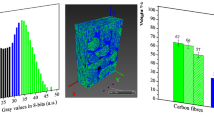Abstract
Uncoated and 300 nm pyrocarbon coated polyacrylonitril (PAN) based T300 type carbon fibres were pressure infiltrated with molten Mg8Li and Mg12Li alloys at 903 K and 963 K, respectively, and at contact times of 4 s and 30 s. The fracture surfaces were characterized by in-situ Auger electron spectroscopy (AES) to investigate the reason for differences in mechanical properties, which were obtained by tensile strength experiments. Pressure increase occurred during the fracture of all the MgLi samples under ultra high vacuum conditions in the analyzer chamber of the AES apparatus, indicating porosity probably due to poor wetting of the fibres during the infiltration process. As visible in the scanning electron micrographs, the pyrocarbon coated carbon fibres were less attacked by the molten MgLi than the uncoated fibres. The damage seemed to increase, the higher the Li contents, the higher the contact time and the higher the temperature were chosen, whereas pyrocarbon coating may retard this affection. Characteristic objects of the sample fracture surfaces (fibre fracture surface, fibre jacket surface, fibre impression surface and matrix) were investigated by laterally high resolution Auger electron spectroscopy. Oxygen was found to be distributed all over the fracture surfaces of the as-fractured samples, and Mg/Li were identified in a chemically bound form. On all the characteristic objects carbide (Li2C2) formation has been detected. Factor analysis was performed to exctract the principal components from the whole set of differentiated Auger electron spectra in the Mg/Li, C and O spectral regions, respectively. Cluster analysis of the weighting factors (the factor loadings) of the most important principal components lead to a separation of the data set into two main groups due to the presence or absence of a strong carbide C (KVV) peak as result of Ar+ sputter removal of the covering oxide layer; no separation of the objects concerning the reaction conditions was found.
Similar content being viewed by others
Author information
Authors and Affiliations
Additional information
Received: 18 June 1996 / Revised: 26 July 1996 / Accepted: 30 July 1996
Rights and permissions
About this article
Cite this article
John, A., Baunack, S., Kúdela, S. et al. In-situ fracture investigations of MgLi-carbon fibre composite materials by AES and data analysis by means of factor and cluster analysis. Fresenius J Anal Chem 357, 886–893 (1997). https://doi.org/10.1007/s002160050268
Issue Date:
DOI: https://doi.org/10.1007/s002160050268




